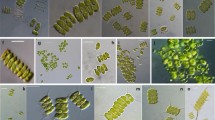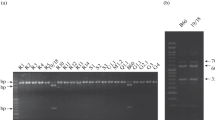Abstract
Dunaliella acidophila is one of the most extreme acidophiles on earth and is able to survive in highly acidic habitats. This characteristic has made this organism the universal model for the study of abiotic stress. Although D. acidophila is currently circumscribed to the subgenus Pascheria within Dunaliella Teodoresco (Chlorophyceae), its taxonomic position has stirred controversy. The comparison of D. acidophila CCAP19/35 internal transcribed spacers (including ITS2 secondary structure analysis) and RuBisCo large subunit (rbcL) sequences with other Dunaliella species confirms that D. acidophila should maintain its phylogenetic position within the genus Dunaliella, suggesting its inclusion within the subgenus Dunaliella. Furthermore, the ITS1 and ITS2 data revealed that D. acidophila was highly divergent from the other freshwater species assessed, D. lateralis, with which it barely shares a 56.8% similarity.

Similar content being viewed by others
References
Akaike H (1979) A new look at the statistical model identification. IEEE Trans Autom Control 19:716–723
Alfaro ME, Zoller S, Lutzoni F (2003) Bayes or bootstrap. A simulation study comparing the performance of Bayesian Markov chain Monte Carlo sampling and bootstrapping in assessing phylogenetic confidence. Mol Biol Evol 20:255–266
Borowitzka MA, Siva CJ (2007) The taxonomy of the genus Dunaliella (Chlorophyta, Dunaliellales) with emphasis on the marine and halophilic species. J Appl Phycol 19:567–590
Buchheim MA, Kirkwood AE, Buchheim JA, Verghese B, Henley WJ (2010) Hypersaline soil supports a diverse community of Dunaliella (Chlorophyceae). J Phycol 46:1038–1047
Calonje M, Martín-Bravo S, Dobeš C, Gong W, Jordon-Thaden I, Kiefer C, Kiefer M, Paule J, Schmickl R, Koch MA (2009) Non-coding nuclear DNA markers in phylogenetic reconstruction. Plant Syst Evol 282:257–280
Ciniglia C, Cennamo P, Pollio A, Pinto G (2009) Phylogenetic relationships and taxonomic position of Dunaliella acidophila isolates from acidic and thermal environments. Phycologia 48:21–22
Coleman AW (2003) ITS2 is a double-edged tool for eukaryote evolutionary comparisons. Trends Genet 19:370–375
Ettl H (1965) Untersuchungen an Flagellaten. Österr Bot Z 112:701–745
Friedrich J, Dandekar T, Wolf M, Müller T (2005) ProfDist: a tool for the construction of large phylogenetic trees based on profile distances. Bioinformatics 21:2108–2109
Gimmler H, Weis U (1992) DunalieIla acidophila—life at pH 1.0. In: Avron M, Ben-Amotz A (eds) Dunaliella: physiology, biochemistry and biotechnology. CRC, Boca Ratón, pp 99–134
Goff LJ, Moon DA, Coleman AW (1994) Molecular delineation of species and species relationships in the red algal agarophytes Gracilariopsis and Gracilaria. J Phycol 30:521–537
Gomez PI, Gonzalez MA (2004) Genetic variation among seven strains of Dunaliella salina (Chlorophyta) with industrial potential, based on RAPD banding patterns and on nuclear ITS rDNA sequences. Aquaculture 233:149–162
González MA, Gómez PI, Montoya R (1999) Comparison of PCR-RFLP analysis of the ITS region with morphological criteria of various strains of Dunaliella. J Appl Phycol 10:573–580
González MA, Coleman AW, Gómez PI, Montoya R (2001) Phylogenetic relationship among various strains of Dunaliella (Chlorophyceae) based on nuclear ITS rDNA sequences. J Phycol 37:604–611
González MA, Gómez PI, Polle JEW (2009) Taxonomy and phylogeny of the genus Dunaliella. In: Ben-Amotz A, Polle JEW, Subba Rao DV (eds) The alga Dunaliella: biodiversity, physiology, genomics and biotechnology. Science Publishers, New Hampshire, pp 1–13
Hall TA (1999) Bioedit: a user-friendly biological sequence alignment editor and analysis program for Windows 95/98/NT. Nucl Acids Symp Ser 41:95–98
Hejazi MA, Barzegari A, Gharajeh NH, Hejazi MS (2010) Introduction of a novel 18S rDNA gene arrangement along with distinct ITS region in the saline water microalga Dunaliella. Saline Syst 6:4
Kalina T (1965) Zur Morphologie und Taxonomie der Gattung Spermatozopsis Korschikow (Volvocales). Spermatozopsis acidophila sp n Preslia 37:9–12
Kelchner SA (2000) The evolution of non-coding chloroplast DNA and its application in plant systematic. Ann Mo Bot Gard 87:482–498
Koetschan C, Förster F, Keller A, Schleicher T, Ruderisch B, Schwarz R, Müller T, Wolf M, Schultz J (2010) The ITS2 Database III—sequences and structures for phylogeny. Nucleic Acids Res 38:D275–D279
Larget B, Simon DL (1999) Markov chain Monte Carlo algorithms for the Bayesian analysis of phylogenetic trees. Mol Biol Evol 16:750–759
Massyuk NP (1971) New species of Dunaliella with asymmetrical cells. Ukr Bot Zh 28:148
Massyuk NP (1972) Phylogenetic and taxonomy of the genus Dunaliella. Ukr Bo Zh 29:744–749
Melkonian M, Preisig HR (1984) An ultrastructural comparison between Spermatopsis and Dunaliella (Chlorophyceae). Pl Syst Evol 164:31–46
Müller T, Rahmann S, Dandekar T, Wolf M (2004) Accurate and Robust phylogeny estimation based on profile distances: a study of the Chlorophyceae (Chlorophyta). BMC Evol Biol 4:20
Nozaki H, Ito M, Sano R, Uchida H, Watanabe MM, Takahashi H (1995) Phylogenetic relationships within the colonial Volvocales (Chlorophyta) inferred from rbcL gene sequence data. J Phycol 31:970–979
Nozaki H, Ito M, Sano R, Uchida H, Watanabe MM, Takahashi H, Kuroiwa T (1997) Phylogenetic analysis of Yamagishiella and Platydorina (Volvocaceae, Chlorophyta) based on rbcL gene sequences. J Phycol 33:272–278
Nozaki H, Misumi O, Kuroiwa T (2003) Phylogeny of the quadriflagellate Volvocales (Chlorophyceae) based on chloroplast multigene sequences. Mol Phylogenet Evol 29:58–66
Nylander JAA (2004) MrModeltest v2. Program distributed by the author. Evolutionary Biology Center, Uppsala University
Page RDM (1996) TreeView: an application to display phylogenetic trees on personal computers. Comp Appl Biosci 12:357–358
Pick U (1999) Dunaliella acidophila—a most extreme acidophilic alga. In: Seckbach J (ed) Enigmatic microorganisms and life in extreme environments. Kluwer, Dordrecht, pp 465–478
Polle JEW, Struwe L, Jin E (2008) Identification and characterization of a new strain of the unicellular green alga Dunaliella salina (Teod.) from Korea. J Microbiol Biotechnol 18:821–827
Polle JEW, Tran D, Ben-Amotz A (2009) History, distribution and habitats of algae of the genus Dunaliella Teodoresco (Chlorophyceae). In: Ben-Amotz A, Polle JEW, Subba Rao DV (eds) The alga Dunaliella: biodiversity, physiology, genomics and biotechnology. Science Publishers, New Hampshire, pp 1–13
Preisig HR (1992) Morphology and taxonomy. In: Avron M, Ben-Amotz A (eds) Dunaliella: Physiology, biochemistry and biotechnology. CRC, Boca Raton, pp 1–15
Rahmann S, Müller T, Dandekar T, Wolf M (2006) Efficient and robust analysis of large phylogenetic datasets. In: Hsu H-H (ed) Advanced data mining technologies in bioinformatics. Idea Group, Inc., Hershey, PA, pp 104–117
Richlen ML, Barber PH (2005) A technique for the rapid extraction of microalgal DNA from single live and preserved cells. Mol Ecol Notes 5:688–691
Ronquist R, Huelsenbeck JP (2003) MrBayes v. 3: Bayesian phylogenetic inference under mixed models. Bioinformatics 19:1572–1574
Schultz J, Wolf M (2009) ITS2 sequence–structure analysis in phylogenetics: a how-to manual for molecular systematics. Mol Phylogenet Evol 52:520–523
Schultz J, Müller T, Achtziger M, Seibel PN, Dandekar T, Wolf M (2006) The internal transcribed spacer 2 database—a web server for (not only) low level phylogenetic analyses. Nucleic Acids Res 34:W704–W707
Seibel PN, Müller T, Dandekar T, Schultz J, Wolf M (2006) 4SALE—a tool for synchronous RNA sequence and secondary structure alignment and editing. BMC Bioinform 7:498
Seibel PN, Müller T, Dandekar T, Wolf M (2008) Synchronous visual analysis and editing of RNA sequence and secondary structure alignments using 4SALE. BMC Res Notes 1:91
Selig C, Wolf M, Müller T, Dandekar T, Schultz J (2008) The ITS2 Database II: homology modelling RNA structure for molecular systematics. Nucleic Acids Res 36:D377–D380
Swofford DL (2002) PAUP*: phylogenetic analysis using parsimony (*and other methods), version 4. Sinauer Associates, Sunderland
Thompson JD, Higgins DG, Gibson TJ (1994) CLUSTAL W: improving the sensitivity of progressive multiple sequence alignment through sequence weighting, positions-specific gap penalties and weight matrix choice. Nucleic Acids Res 22:4673–4680
Wolf M, Achtziger M, Schultz J, Dandekar T, Müller T (2005) Homology modeling revealed more than 20,000 rRNA internal transcribed spacer 2 (ITS2) secondary structures. RNA 11:1616–1623
Wolf M, Ruderisch B, Dandekar T, Müller T (2008) ProfdistS: (Profile-) distance based phylogeny on sequence–structure alignments. Bioinformatics 24:2401–2402
Acknowledgements
This research was supported by BANGEN-Banco Genético de la Macaronesia (INTERREG-IIIB, MAC/1/C070). We thank the Cabildo de Gran Canaria for allowing the collaboration of the Departamento de Biodiversidad Molecular y Banco de ADN at the Jardín Botánico Canario “Viera y Clavijo”–Unidad Asociada CSIC, and for continuous support to all its research lines. We also thank Dr. Hisayoshi Nozaki (University of Tokyo, Japan) and Dr. Mark A. Buchheim (The University of Tulsa, OK, USA) for their recommendations regarding rbcL primers. Finally, we would like to thank Dr. Matthias Wolf (University of Wuerzburg, Germany) for his help with the software for the ITS2 secondary structure analysis.
Author information
Authors and Affiliations
Corresponding authors
Electronic supplementary materials
Below is the link to the electronic supplementary material.
Table 1
Species, culture collections, origin, ITS and rbcL Genbank accession numbers of the strains included in this study. (DOC 95 kb)
Fig. 1
Distance tree obtained with the ITS2 secondary structure analysis of Dunaliella species (see material & methods). (JPEG 223 kb)
Rights and permissions
About this article
Cite this article
Assunção, P., Jaén-Molina, R., Caujapé-Castells, J. et al. Phylogenetic position of Dunaliella acidophila (Chlorophyceae) based on ITS and rbcL sequences. J Appl Phycol 24, 635–639 (2012). https://doi.org/10.1007/s10811-011-9676-1
Received:
Revised:
Accepted:
Published:
Issue Date:
DOI: https://doi.org/10.1007/s10811-011-9676-1




